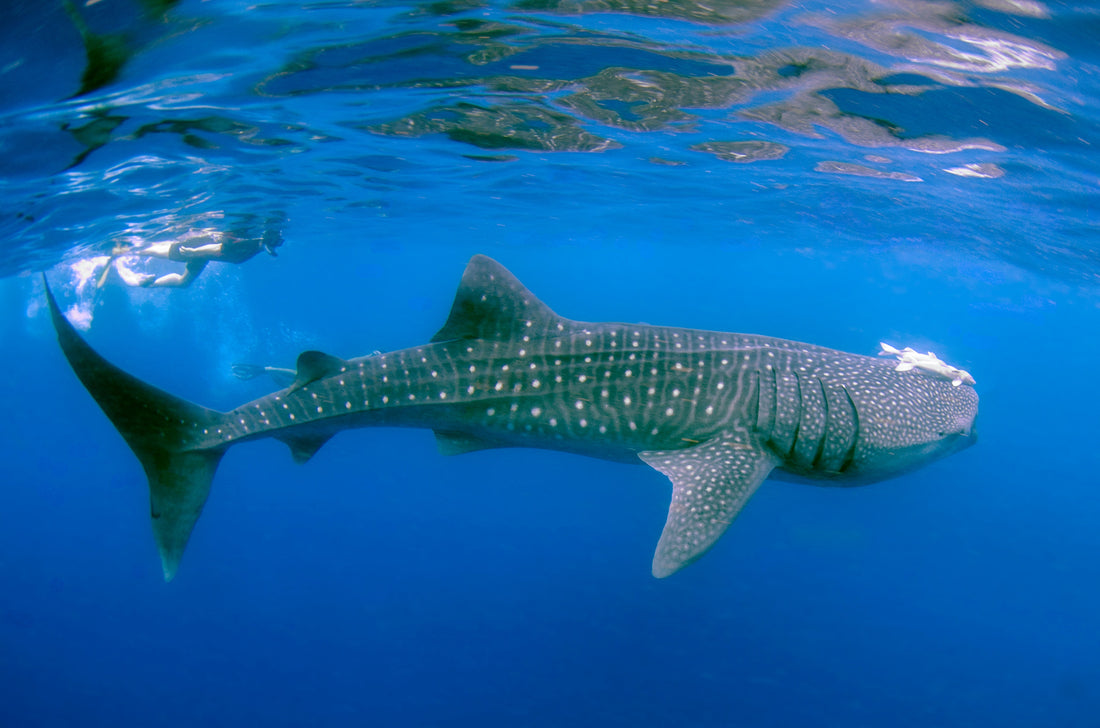Scuba diving often invokes an indescribable feeling of wonder, fearlessness, and gratefulness that’s unlike anything ever felt on land. Swimming with massive creatures that can be up to 40 feet long and weigh nearly 40,000 pounds? That’s one of those breathtaking moments.
Whale sharks are the world’s largest (and longest living!) fish. They have blue/grey coloring with distinct white spots and stripes along their backs. Whale sharks are filter feeders, which means they swim with their mouths wide open in hopes of sifting tiny plankton, fish, and the occasional squid. Because these gentle giants feed on plankton, they tend to hang out toward the surface of warm, tropical waters all around the world. That makes it easy for people to spot, swim with, or scuba dive with whale sharks.
Unfortunately, the global population of whale sharks continues to decrease; in 2016, the gentle giants were listed as endangered by the International Union for Conservation of Nature (IUCN). Tourism and whale shark fishing industries are threats to whale shark populations worldwide. When booking a whale shark encounter, make sure to choose an ethical operator with a background in conservation and strict guidelines for shark-friendly interactions. Whale sharks are easily disturbed by our presence and should never be touched, chased, or harassed.
With that in mind, we rounded up the best places to swim with whale sharks around the world.
Ningaloo, Western Australia

Australia is known for hosting a range of exotic marine life. Here you can find the smallest and one of the most venomous jellyfish in the world — the Irukandji jellyfish — and the largest and most gentle fish in the world, the whale shark.
Ningaloo, a World Heritage site off the coast of Exmouth, is the best location for diving with whale sharks in Australia. The healthy coral reef system is known for its nutrient-rich waters that attract a variety of marine life. Plankton concentrates around Ningaloo Reef following the coral spawning in March and April — and this, of course, attracts hungry whale sharks to the reef.
Whale shark season in Western Australia runs from March to August. During this time of year, there are plenty of eco-friendly tours in Exmouth that facilitate safe snorkeling or diving with whale sharks, such as Whale Shark N’ Dive.
Ari Atoll, Maldives

Whale sharks love the warm temperatures of the Indian Ocean, especially around the Maldives. These warm, tropical waters allow whale sharks to find food and swim in a safe environment without the threat of predators. Ari Atoll is the most popular spot to swim with whale sharks in the Maldives, particularly from August through December. There’s also a good chance of spotting massive manta rays around this chain of islands, too!
Galapagos Islands, Ecuador

Fun fact: up to 90% of all whale shark sightings in the Galapagos are pregnant females. And because of that, it’s also the best place to dive with really big whale sharks as adult females can reach up to 40 feet in length!
Scientists are still unsure why these volcanic islands are a hot spot for the ladies. And no one has ever observed a whale shark give birth. The females tend to migrate into the Pacific and toward the continental shelf while they’re still pregnant.
You have a high chance of diving with whale sharks in the northernmost islands of Darwin and Wolf from June to November. Keep in mind, it’s not an easily accessible diving destination. (Looking at this map, you’ll see what we mean.) Darwin is 180 miles north of the main town in the Galapagos (Puerto Ayora); from there, you have to hop on a multi-day scuba diving liveaboard to get to Darwin’s Arch. Plan it right, and it could be a very rewarding experience.
Donsol Bay, Philippines

Over 7,000 islands make up the Philipines, but the sleepy fishing village of Donsol is the most popular spot for whale shark encounters. Whale shark tours are highly regulated in Donsol Bay, and you’re not actually allowed to scuba dive with the gentle creatures. But snorkeling is permitted. The best time of year to swim with whale sharks in the Philippines is from December to May. Although, February to April is peak season.
Isla Mujeres, Mexico

Summer is spawning season for tunny fish, which means millions of eggs are floating in the water off the coast of Mexico’s Yucatán Peninsula. This, plus bountiful plankton, attracts whale sharks to the 80-degree waters of the Caribbean. In fact, a 2009 gathering between Isla Contoy and Isla Mujeres recorded the largest aggregation of whale sharks in the world. If you’re interested in swimming with whale sharks in Mexico, May through August is the best time of year to jump in.
Tofo Beach, Mozambique

Because of its remote location in East Africa, Mozambique is an unspoiled and quiet location to scuba dive with whale sharks. Tofo Beach, in particular, is a diving haven as it’s the best place to spot manta rays, dolphins, and sea turtles.
From June to January, you can dive or swim with whale sharks in Mozambique. Tofo Beach is known for having the largest concentration of whale sharks in Africa almost year-round, although the best time to visit is in October due to phytoplankton bloom. There’s also a high chance of spotting humpback whales from June to October!

Grateful Diver supplies gear to support your biggest adventures. And you can bet that includes diving with whale sharks! A portion of every purchase goes to Reef Relief, a nonprofit organization dedicated to improving and protecting our coral reef ecosystem, which in turn will attract more beautiful creatures to the Florida Keys. In fact, small aggregations of whale sharks are sometimes spotted in the Flower Garden Banks National Marine Sanctuary and the Florida Keys National Marine Sanctuary during the winter months!
Together, we can support Reef Relief in its conservation efforts and work towards maintaining healthy and sustainable habitats for marine life.

